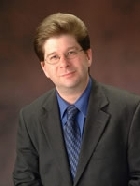Refocusing Fat: Cosmetic Surgery’s Regenerative Medicine Approach
“The fat being liposuctioned from your behind may have some uses after all,” says Dr. Rubin.

When not working on adipose metabolism and metabolic effects of large volume liposuction in collaboration with a multidisciplinary team of obesity researchers, McGowan Institute faculty member J. Peter Rubin, MD (pictured), Director of the Life After Weight Loss clinical program at the University of Pittsburgh Medical Center (UPMC), is looking into manipulating and transferring a patient’s own fat from one part of the body to another for aesthetic intentions.
Many plastic surgery products available to Dr. Rubin inflate tissues to enhance one’s looks. Some of these products are permanent until surgically removed (i.e., silicone breast implants) or semi-permanent until naturally degraded (i.e., dermal filler made of a biodegradable non-animal stabilized hyaluronic acid). It is the latter challenge—preventing natural degradation within the body—that Dr. Rubin is exploring a remedy.
An area of continued cosmetic interest for enhancement is the face. As we age, it can become full of uninvited wrinkles and facial folds. Fat-rich areas of the body are the buttocks. Again, as we age, they can lose their muscle density only to be replaced by unwelcomed fat pads. By filling those age-defining lines on your face with unwanted adipose from your posterior, a regenerative medicine approach for cosmetic surgery appears promising.
“The fat being liposuctioned from your behind may have some uses after all,” says Dr. Rubin.
Dr. Rubin and his colleagues have found that fat tissue is a rich source of adult stem cells, which can be induced to turn into other types of tissue, or introduced into a site of injury and serve in a healing capacity. Dr. Rubin was recently recognized for his groundbreaking research on using fat-derived stem cells to engineer soft tissue. NIH Director, Dr. Elias Zirhouni, presented Dr. Rubin with the 2007 Presidential Early Career Award for Science and Engineering (PECASE). The PECASE is the nation’s highest honor for scientists who are early in their careers and given to acknowledge and support researchers whose initial work shows exceptional promise for leadership at the frontiers of scientific knowledge during the twenty-first century.
In his work, Dr. Rubin has extracted stem cells from liposuction fat and then used these cells to grow new batches of fat in animal studies. He imagines injecting a gel of stem cells primed to produce fat into the face in someone in their 20s or 30s so that they never lose the fat, and to prevent wrinkles and sagging in the first place. Although the suggestion is something for patients to look forward to, Dr. Rubin adds that U.S. human trials are still several years off.
Dr. Rubin is also Director of the Adipocyte Biology Laboratory, Co-Director of the UPMC Aesthetic Surgery Center, and an assistant professor in the division of plastic surgery at the University of Pittsburgh.
Illustration: McGowan Institute for Regenerative Medicine.
Read more…
MSNBC (04/24/08)
Life After Weight Loss
UPMC Department of Surgery, Division of Plastic & Reconstructive Surgery
Dr. Rubin's Regenerative Medicine Efforts Receive Presidential Early Career Award for Science and Engineering
Many plastic surgery products available to Dr. Rubin inflate tissues to enhance one’s looks. Some of these products are permanent until surgically removed (i.e., silicone breast implants) or semi-permanent until naturally degraded (i.e., dermal filler made of a biodegradable non-animal stabilized hyaluronic acid). It is the latter challenge—preventing natural degradation within the body—that Dr. Rubin is exploring a remedy.
An area of continued cosmetic interest for enhancement is the face. As we age, it can become full of uninvited wrinkles and facial folds. Fat-rich areas of the body are the buttocks. Again, as we age, they can lose their muscle density only to be replaced by unwelcomed fat pads. By filling those age-defining lines on your face with unwanted adipose from your posterior, a regenerative medicine approach for cosmetic surgery appears promising.
“The fat being liposuctioned from your behind may have some uses after all,” says Dr. Rubin.
Dr. Rubin and his colleagues have found that fat tissue is a rich source of adult stem cells, which can be induced to turn into other types of tissue, or introduced into a site of injury and serve in a healing capacity. Dr. Rubin was recently recognized for his groundbreaking research on using fat-derived stem cells to engineer soft tissue. NIH Director, Dr. Elias Zirhouni, presented Dr. Rubin with the 2007 Presidential Early Career Award for Science and Engineering (PECASE). The PECASE is the nation’s highest honor for scientists who are early in their careers and given to acknowledge and support researchers whose initial work shows exceptional promise for leadership at the frontiers of scientific knowledge during the twenty-first century.
In his work, Dr. Rubin has extracted stem cells from liposuction fat and then used these cells to grow new batches of fat in animal studies. He imagines injecting a gel of stem cells primed to produce fat into the face in someone in their 20s or 30s so that they never lose the fat, and to prevent wrinkles and sagging in the first place. Although the suggestion is something for patients to look forward to, Dr. Rubin adds that U.S. human trials are still several years off.
Dr. Rubin is also Director of the Adipocyte Biology Laboratory, Co-Director of the UPMC Aesthetic Surgery Center, and an assistant professor in the division of plastic surgery at the University of Pittsburgh.
Illustration: McGowan Institute for Regenerative Medicine.
Read more…
MSNBC (04/24/08)
Life After Weight Loss
UPMC Department of Surgery, Division of Plastic & Reconstructive Surgery
Dr. Rubin's Regenerative Medicine Efforts Receive Presidential Early Career Award for Science and Engineering
